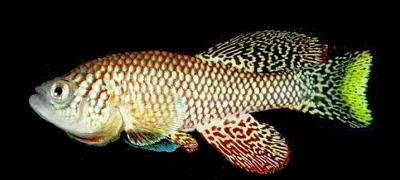 Elsewhere, a
team from Indiana University and
Dartmouth College has identified genes and regulatory patterns that allow some
organisms to alter their body form in response to environmental change.
Understanding how an organism adopts a new function to thrive in changing
environments has implications for molecular evolution and many areas of science
from climate change to medicine, especially in regeneration and wound healing. The researchers examined how the Atlantic killifish
modifies its gills to live in freshwater or seawater.
The name killifish
is often used to describe small fish of the Fundulus genus. In Rhode Island, at
least two species of Fundulus are present: the common mummichog and the striped
killifish. The body shape of these fish is standard for both species. Both have
a rounded back and belly, a soft dorsal fin situated far back on the body, a
thick and rounded tail, a flattened head, a blunt snout, and a small mouth. A
killifish is any of various oviparous (egg-laying) cyprinodontiform fish. Because of living in ephemeral waters, the
eggs of most killifish can survive periods of partial dehydration.
Here is something
very interesting read in BBC today -
: When
we think of fish, there are certain assumptions we make. There are male fish,
and female fish, and these fish mate to create little fish, which inherit
traits from both parents. Over a few years, the little fish grow and grow,
until they become old fish. Fish live in
water only. We take that one for granted – hence the phrase "a fish out of
water", meaning something weird or odd, something that shouldn't be. They swim, ideally in huge expanses of water,
such as rivers, lakes, seas and oceans.
However,
there is one group of fish that does not follow any of these rules. Kriptolebias
marmoratus can create clones of itself - Known as killifish, these small
innocuous-looking creatures measure just a few inches long. Many species are
flamboyant and kept as pets in aquaria. But others look ordinary, and in their
own way are among the oddest fish on the planet, a few can claim to be the
world's most extreme. That's because some killifish don't reproduce like other
fish. In fact, one species doesn't reproduce in the same way as any other
vertebrate.
Elsewhere, a
team from Indiana University and
Dartmouth College has identified genes and regulatory patterns that allow some
organisms to alter their body form in response to environmental change.
Understanding how an organism adopts a new function to thrive in changing
environments has implications for molecular evolution and many areas of science
from climate change to medicine, especially in regeneration and wound healing. The researchers examined how the Atlantic killifish
modifies its gills to live in freshwater or seawater.
The name killifish
is often used to describe small fish of the Fundulus genus. In Rhode Island, at
least two species of Fundulus are present: the common mummichog and the striped
killifish. The body shape of these fish is standard for both species. Both have
a rounded back and belly, a soft dorsal fin situated far back on the body, a
thick and rounded tail, a flattened head, a blunt snout, and a small mouth. A
killifish is any of various oviparous (egg-laying) cyprinodontiform fish. Because of living in ephemeral waters, the
eggs of most killifish can survive periods of partial dehydration.
Here is something
very interesting read in BBC today -
: When
we think of fish, there are certain assumptions we make. There are male fish,
and female fish, and these fish mate to create little fish, which inherit
traits from both parents. Over a few years, the little fish grow and grow,
until they become old fish. Fish live in
water only. We take that one for granted – hence the phrase "a fish out of
water", meaning something weird or odd, something that shouldn't be. They swim, ideally in huge expanses of water,
such as rivers, lakes, seas and oceans.
However,
there is one group of fish that does not follow any of these rules. Kriptolebias
marmoratus can create clones of itself - Known as killifish, these small
innocuous-looking creatures measure just a few inches long. Many species are
flamboyant and kept as pets in aquaria. But others look ordinary, and in their
own way are among the oddest fish on the planet, a few can claim to be the
world's most extreme. That's because some killifish don't reproduce like other
fish. In fact, one species doesn't reproduce in the same way as any other
vertebrate.
 Killifish
don't like to grow old – well, not old in the conventional sense. They don't
mature like other fish, and many killifish species will live and die with a
year. One species survives for less than three months, making it among the
shortest-lived of all known vertebrates. They have other ways of breathing,
apart from using their gills.
And
swimming isn't really their thing. They prefer to live puddles and pools, and
have evolved their whole life strategy to cope without water, rather than with
it. Some species can survive out of water for more than two months. They will
leave it to go for a walk and they even hunt on land. There are a number of
killifish species living across Africa and South America. Most are adapted to
living in places where water is scarce, or where water levels change
drastically from season to season.
Some
do live in larger bodies of water, but many survive in isolated pools, created
as lakes and rivers periodically dry. At that point all the fish perish
!!! that creates a fundamental challenge
– how do the fish survive and reproduce when the water eventually runs out? A
new review of how killifish do thishas just been published in the journal
Biological Reviewsby Andrew Furness at the University of California, Riverside
in the US. One major adaption, which
different killifish species have independently evolved, is to live their whole
lives within a single year, using a number of unique tricks. During the wet
season, when pools are full, the fish hatch. They quickly grow to maturity and
start spawning, which they keep doing until the pools start to dry. At that
point all the fish perish. This cycle of life can be so quick that one species,
the turquoise killifish (Nothobranchius furzeri) of equatorial Africa, lives
for an average of just 10 weeks. The mangrove killifish is the only known
vertebrate hermaphrodite that can fertilise itself....... but, they leave behind eggs in the soil, and these
eggs represent the entire surviving populations of killifish.
These
eggs survive the dry season in a dormant state, or diapause, buried in the soil
until the following rainy season. The return of the rains causes eggs to hatch
and the cycle begins anew, says Furness. To do this, different killifish are
able to stopping growing as embryos, and then start again when conditions are
right. And they can stop at different times during their development, delaying
the growth of major organs, such their skulls, hearts and circulatory systems.
They can then delay hatching for days, weeks or months.
Most
fish breathe with their gills, passing water over them to extract oxygen. The
mangrove killifish however, can also breathe through its skin. That’s critical
for the fish's survival as mangrove killifish live in the most extreme habitat,
within the mangrove forests of the west Atlantic, a tangle of thick tree roots
and deep mud.Other fish species frequent mangroves, but they usually move in
and out as water conditions vary. Mangrove killifish spend their whole lives
here. This water then disappears during the dry season, leaving the fish high
and dry. Some survive in diminishing pools, while others are left clinging to
the mud or tree branches. Essentially, the fish have moved onto land as the
water recedes, and survive by breathing air through their skin. They even
excrete waste through their skin and tests have shown that mangrove killifish
can survive out of water for up to 66 days.
Extreme,
very interesting and some which we would have deemed as not facts, indeed.
With regards – S.
Sampathkumar
22nd May
2015.
Source :
www.bbc.co.uk.
Killifish
don't like to grow old – well, not old in the conventional sense. They don't
mature like other fish, and many killifish species will live and die with a
year. One species survives for less than three months, making it among the
shortest-lived of all known vertebrates. They have other ways of breathing,
apart from using their gills.
And
swimming isn't really their thing. They prefer to live puddles and pools, and
have evolved their whole life strategy to cope without water, rather than with
it. Some species can survive out of water for more than two months. They will
leave it to go for a walk and they even hunt on land. There are a number of
killifish species living across Africa and South America. Most are adapted to
living in places where water is scarce, or where water levels change
drastically from season to season.
Some
do live in larger bodies of water, but many survive in isolated pools, created
as lakes and rivers periodically dry. At that point all the fish perish
!!! that creates a fundamental challenge
– how do the fish survive and reproduce when the water eventually runs out? A
new review of how killifish do thishas just been published in the journal
Biological Reviewsby Andrew Furness at the University of California, Riverside
in the US. One major adaption, which
different killifish species have independently evolved, is to live their whole
lives within a single year, using a number of unique tricks. During the wet
season, when pools are full, the fish hatch. They quickly grow to maturity and
start spawning, which they keep doing until the pools start to dry. At that
point all the fish perish. This cycle of life can be so quick that one species,
the turquoise killifish (Nothobranchius furzeri) of equatorial Africa, lives
for an average of just 10 weeks. The mangrove killifish is the only known
vertebrate hermaphrodite that can fertilise itself....... but, they leave behind eggs in the soil, and these
eggs represent the entire surviving populations of killifish.
These
eggs survive the dry season in a dormant state, or diapause, buried in the soil
until the following rainy season. The return of the rains causes eggs to hatch
and the cycle begins anew, says Furness. To do this, different killifish are
able to stopping growing as embryos, and then start again when conditions are
right. And they can stop at different times during their development, delaying
the growth of major organs, such their skulls, hearts and circulatory systems.
They can then delay hatching for days, weeks or months.
Most
fish breathe with their gills, passing water over them to extract oxygen. The
mangrove killifish however, can also breathe through its skin. That’s critical
for the fish's survival as mangrove killifish live in the most extreme habitat,
within the mangrove forests of the west Atlantic, a tangle of thick tree roots
and deep mud.Other fish species frequent mangroves, but they usually move in
and out as water conditions vary. Mangrove killifish spend their whole lives
here. This water then disappears during the dry season, leaving the fish high
and dry. Some survive in diminishing pools, while others are left clinging to
the mud or tree branches. Essentially, the fish have moved onto land as the
water recedes, and survive by breathing air through their skin. They even
excrete waste through their skin and tests have shown that mangrove killifish
can survive out of water for up to 66 days.
Extreme,
very interesting and some which we would have deemed as not facts, indeed.
With regards – S.
Sampathkumar
22nd May
2015.
Source :
www.bbc.co.uk.

